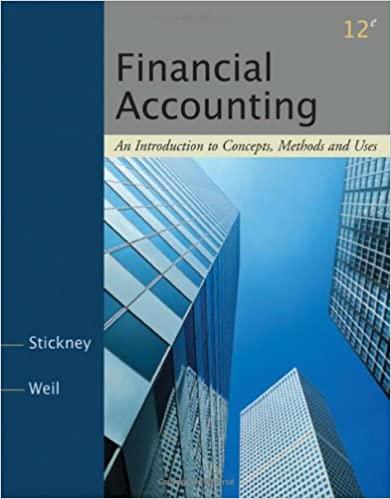Question
1 . Current assets include cash and all other assets expected to become cash or be consumed: a.) Within one year. b.) Within one operating
1. Current assets include cash and all other assets expected to become cash or be consumed:
a.) Within one year.
b.) Within one operating cycle.
c.) Within one year or one operating cycle, whichever is shorter.
d.) Within one year or one operating cycle, whichever is longer.
2. Working capital is equal to:
a.) Current assets.
b.) Current liabilities.
c.) Current assets plus current liabilities.
d.) Current assets minus current liabilities.
3.
| Listed below are year-end account balances (in $millions) taken from the records of Symphony Stores. |
|
| Debit | Credit |
| Accounts receivable-trade | 688 |
|
| Building and equipment | 932 |
|
| Cash-checking | 45 |
|
| Interest receivable | 32 |
|
| Inventory | 20 |
|
| Land | 167 |
|
| Notes receivable (long-term) | 453 |
|
| Petty cash fund | 8 |
|
| Prepaid rent | 25 |
|
| Supplies | 10 |
|
| Trademark | 51 |
|
| Accounts payable-trade |
| 617 |
| Accumulated depreciation |
| 65 |
| Additional paid-in capital |
| 483 |
| Allowance for uncollectible accounts |
| 16 |
| Cash dividends payable |
| 20 |
| Common stock, at par |
| 10 |
| Income tax payable |
| 56 |
| Notes payable (long-term) |
| 812 |
| Retained earnings |
| 322 |
| Deferred revenues |
| 30 |
| TOTALS | 2,431 | 2,431 |
|
| |||||||||||||||||||||||||||||||||||||||||||||||||||||||||||||||||||||||||||||||||||||||||||||||||||||||||||||||||||||||||||||||||||||||||||||||||||||||||||||||||||||||||||||||||||||||||||||||||||||||||||||||||||||||||||||||||||||||||||||||||||||||||||||||||||||||||||||||||||||||||||||||||||||||||||||||||||||||||||||||||||||||||||||
| What would Symphony report as total current assets? a.) $1,623 millions. b.) $820 millions. c.) $828 millions. d.) $812 millions. 4.
a.) $1,551 millions. b.) $2,395 millions. c.) $2,470 millions. d.) $2,377 millions.
a. $1,630 millions. b.) $839 millions.
c.) $815 millions.
d.) $791 millions.
6.
a.) $219 millions. b.) $256 millions. c.) $268 millions. d.) $283 millions.
7.
a.) $44,200. b.) $68,700. c.) $64,300. d.) $105,700.
a.) $556 thousand. b.) $148 thousand. c.) $319 thousand. d.) $244 thousand.
9.
a.) 1.87. b.) 1.15. c.) 0.78. d.) 0.53.
|
Step by Step Solution
There are 3 Steps involved in it
Step: 1

Get Instant Access to Expert-Tailored Solutions
See step-by-step solutions with expert insights and AI powered tools for academic success
Step: 2

Step: 3

Ace Your Homework with AI
Get the answers you need in no time with our AI-driven, step-by-step assistance
Get Started


